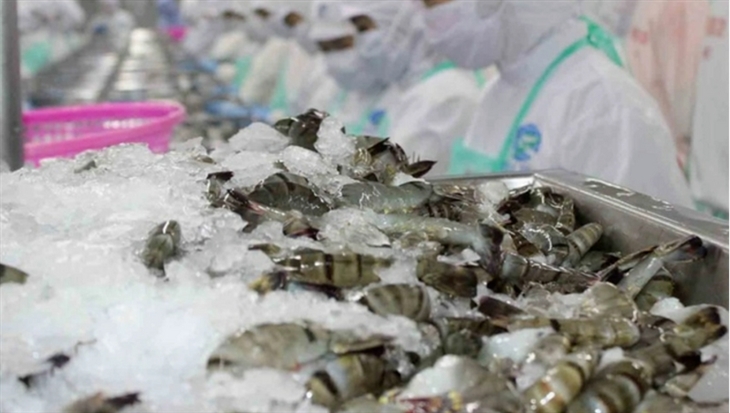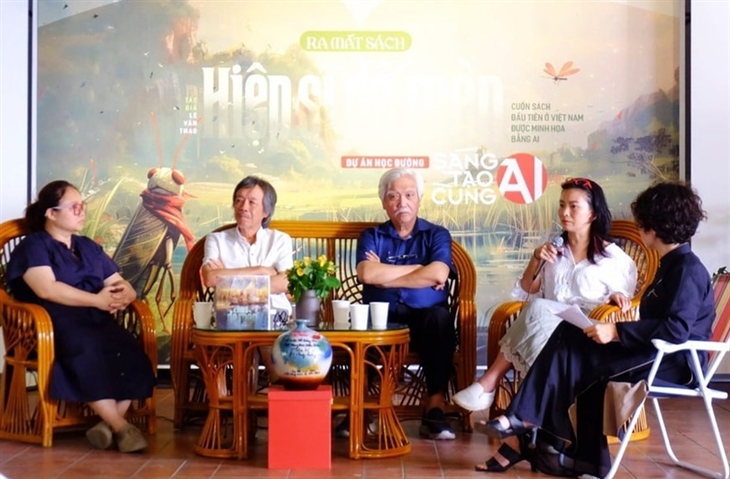Seafood industry aims for 10 billion USD in 2025
Tuesday, August 12,2025
AsemconnectVietnam - Along with market diversification and taking advantage of incentives from agreements such as EVFTA and CPTPP, seafood industry aims for a target of 10 billion USD this year.
Impressive growth in shrimp and pangasius exports
According to estimates from Vietnam Association of Seafood Exporters and Producers (VASEP), in the first 6 months of 2025, total seafood export turnover reached about 5.11 billion USD, an increase of 16% over the same period in 2024. Of which, shrimp exports recorded impressive growth of nearly 2.14 billion USD (up 30.4%), while pangasius brought in about 925 million USD (up 8%).
Mr. Nguyen Hoai Nam - General Secretary of VASEP - commented that this result was achieved thanks to recovery of international market, along with continuous efforts of business community and active support from Vietnamese representative agencies abroad, especially trade offices. In many trade promotion programs in key markets, embassies and trade offices have accompanied and effectively supported seafood enterprises in promoting, connecting and expanding markets.
According to Mr. Nam, the Free Trade Agreements (FTAs) that the Government has negotiated and signed are showing clear effectiveness, bringing many practical benefits to the industry. Tariff incentives, favorable market access conditions and trade openness commitments help businesses improve their competitiveness and expand their export scale.
However, besides positive signals, seafood industry still faces many challenges. Mr. Nhu Van Can - Deputy Director of Department of Fisheries and Fisheries Control, said that tariff barriers, along with European Commission (EC) maintaining the "yellow card" warning for exploited seafood, are affecting international reputation of Vietnamese seafood products. In addition, increasing requirements of import markets for traceability and product legality also put considerable pressure on the industry.
Mr. Ngo Hong Phong - Director of Department of Quality, Processing and Market Development (Ministry of Agriculture and Environment) - assessed that export target of 10 billion USD in 2025 is a big challenge, especially in the context of many difficulties in the US market.
Therefore, in the last 6 months of the year, there must be specific, breakthrough solutions to complete the target. One of important directions is to promote reopening of Chinese market for lobster products, which, if successful, will create new growth momentum. In addition, Brazilian market also opens up new opportunities when it officially loosens physical and chemical regulations on pangasius and allows import of Vietnamese tilapia.
According to Mr. Nguyen Hoai Nam, in upcoming FTA reviews, VASEP expects to have more new incentives, especially for key products such as shrimp and tuna, which are closely linked to livelihoods of Vietnamese farmers and fishermen. Specifically, the Association proposes to open more shrimp quotas in the FTA with Korea and expand tuna quotas in the FTA with the European Union (EU).
Expecting a breakthrough thanks to technological innovation and effective integration
According to assigned target, fisheries sector must achieve a growth rate of 4.35% in 2025. To achieve this goal, Deputy Minister of Agriculture and Rural Development Phung Duc Tien emphasized that it is necessary to focus on the aquaculture sector, in which issue of breeds is the key factor determining production efficiency. Improving the quality and proactively sourcing breeds requires stronger participation from the private sector.
For marine aquaculture, it is necessary to promote application of technology, call on large corporations to participate in large-scale investment, modernize equipment and technology for marine aquaculture. At the same time, it is necessary to build a close chain of links between the stages of farming, processing and consumption. The Deputy Minister also particularly emphasized development of seaweed and algae as a strategic direction with high potential in the context of climate change.
Exploitation sector also needs strong changes, especially in design and construction of new modern fishing vessels, investment in equipment for preserving and processing products right on board. Training of chief engineers and captains must also be focused on to improve operational capacity and sustainable exploitation efficiency.
Regarding conservation of aquatic resources, the Deputy Minister said that it is necessary to conduct a comprehensive review of existing conservation areas and evaluate actual effectiveness. From there, make appropriate proposals, ensuring a balance between exploitation and conservation.
Regarding IUU issue, the Ministry will continue to strengthen inspection and supervision in localities, resolutely deploy necessary solutions to move towards the goal of soon removing the "yellow card" warning from EC.
Source: Vitic/ congthuong.vn
According to estimates from Vietnam Association of Seafood Exporters and Producers (VASEP), in the first 6 months of 2025, total seafood export turnover reached about 5.11 billion USD, an increase of 16% over the same period in 2024. Of which, shrimp exports recorded impressive growth of nearly 2.14 billion USD (up 30.4%), while pangasius brought in about 925 million USD (up 8%).
Mr. Nguyen Hoai Nam - General Secretary of VASEP - commented that this result was achieved thanks to recovery of international market, along with continuous efforts of business community and active support from Vietnamese representative agencies abroad, especially trade offices. In many trade promotion programs in key markets, embassies and trade offices have accompanied and effectively supported seafood enterprises in promoting, connecting and expanding markets.
According to Mr. Nam, the Free Trade Agreements (FTAs) that the Government has negotiated and signed are showing clear effectiveness, bringing many practical benefits to the industry. Tariff incentives, favorable market access conditions and trade openness commitments help businesses improve their competitiveness and expand their export scale.
However, besides positive signals, seafood industry still faces many challenges. Mr. Nhu Van Can - Deputy Director of Department of Fisheries and Fisheries Control, said that tariff barriers, along with European Commission (EC) maintaining the "yellow card" warning for exploited seafood, are affecting international reputation of Vietnamese seafood products. In addition, increasing requirements of import markets for traceability and product legality also put considerable pressure on the industry.
Mr. Ngo Hong Phong - Director of Department of Quality, Processing and Market Development (Ministry of Agriculture and Environment) - assessed that export target of 10 billion USD in 2025 is a big challenge, especially in the context of many difficulties in the US market.
Therefore, in the last 6 months of the year, there must be specific, breakthrough solutions to complete the target. One of important directions is to promote reopening of Chinese market for lobster products, which, if successful, will create new growth momentum. In addition, Brazilian market also opens up new opportunities when it officially loosens physical and chemical regulations on pangasius and allows import of Vietnamese tilapia.
According to Mr. Nguyen Hoai Nam, in upcoming FTA reviews, VASEP expects to have more new incentives, especially for key products such as shrimp and tuna, which are closely linked to livelihoods of Vietnamese farmers and fishermen. Specifically, the Association proposes to open more shrimp quotas in the FTA with Korea and expand tuna quotas in the FTA with the European Union (EU).
Expecting a breakthrough thanks to technological innovation and effective integration
According to assigned target, fisheries sector must achieve a growth rate of 4.35% in 2025. To achieve this goal, Deputy Minister of Agriculture and Rural Development Phung Duc Tien emphasized that it is necessary to focus on the aquaculture sector, in which issue of breeds is the key factor determining production efficiency. Improving the quality and proactively sourcing breeds requires stronger participation from the private sector.
For marine aquaculture, it is necessary to promote application of technology, call on large corporations to participate in large-scale investment, modernize equipment and technology for marine aquaculture. At the same time, it is necessary to build a close chain of links between the stages of farming, processing and consumption. The Deputy Minister also particularly emphasized development of seaweed and algae as a strategic direction with high potential in the context of climate change.
Exploitation sector also needs strong changes, especially in design and construction of new modern fishing vessels, investment in equipment for preserving and processing products right on board. Training of chief engineers and captains must also be focused on to improve operational capacity and sustainable exploitation efficiency.
Regarding conservation of aquatic resources, the Deputy Minister said that it is necessary to conduct a comprehensive review of existing conservation areas and evaluate actual effectiveness. From there, make appropriate proposals, ensuring a balance between exploitation and conservation.
Regarding IUU issue, the Ministry will continue to strengthen inspection and supervision in localities, resolutely deploy necessary solutions to move towards the goal of soon removing the "yellow card" warning from EC.
Source: Vitic/ congthuong.vn
Vietnam - Netherlands trade exchange in July and the first 7 months of 2025
Industrial production index increased in 34 localities in 7 months
Vietnam’s exports, imports and trade balance in first 7 months of 2025
Impacts of EVFTA on Vietnam – Netherlands trade
Expanding ‘rice road’ to the world
Reducing costs from source creates export advantages for Vietnamese agricultural products
Rice industry got trade surplus of 1.81 billion USD
Agricultural, forestry and fishery exports reached nearly 40 billion USD
Seafood exports may grow by double digits
Three strategic pillars for national export mission
Super project on oil refining worth more than 20 billion USD to be built
Africa – potential destination for Vietnamese goods
The seafood industry aims for a target of 10 billion USD in 2025
Fruit and vegetable exports estimated to exceed 3.8 billion USD in 7 months

Plan of Hai Duong province for a period of 2021 - 2030, ...
Organize space reasonably and harmoniously, focusing on connecting Hai Duong in common development space, actively contributing to the ...Plan of Hau Giang province in a period of 2021 - 2030, ...
Sustainable forestry development program in a period of ...

AI opens new path for image industry: Insiders
Though the term "image industry" remains relatively new in the local context, the development of a creative ecosystem driven by AI will ...Hanoi’s street food culture gains ground with Michelin nods
Draw held for 2025 Davis Cup Asia/Oceania Group III in Bac ...
Da Nang Museum opens an exhibition of rare ancient ...
An Giang races to complete UNESCO nomination dossier for ...



